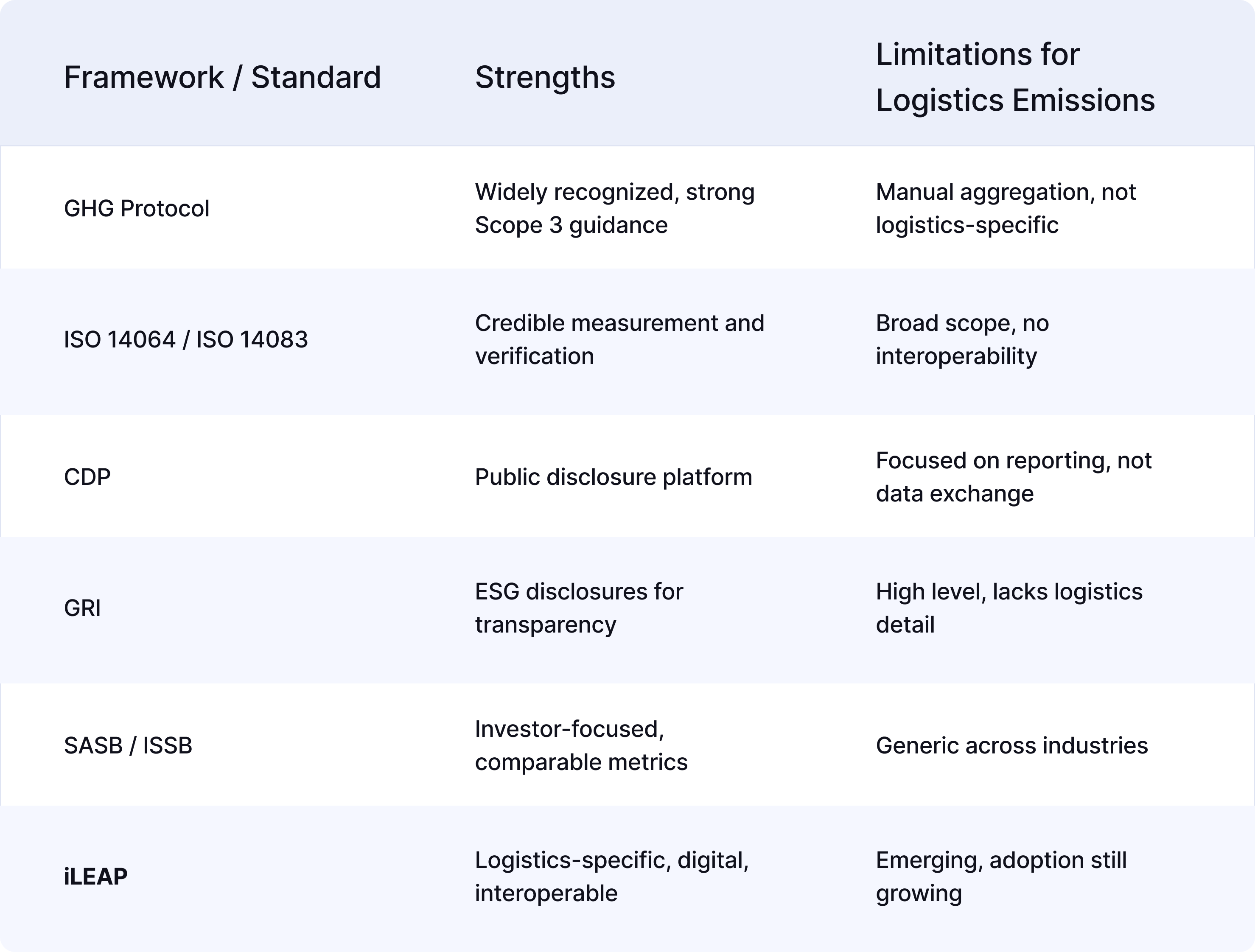.jpg)
From averages to accuracy: Why iLEAP matters for supply chain decarbonization
In this article, learn how iLEAP helps companies move from averages to supplier-specific data in logistics, why it complements existing standards like ISO 14083 and GHG Protocol, and how it creates a practical foundation for supply chain decarbonization.
Sign up to get full access
Link
“Do we really need another emissions framework?”
That’s the first question many companies ask when they hear about iLEAP. With GHG Protocol, ISO standards, CDP questionnaires and endless supplier data requests, the sustainability reporting landscape can already feel overwhelming.
But here’s the thing: iLEAP is not “just another framework.” It is one of the first real attempts to make emissions data exchangeable, comparable and usable across logistics and supply chains. For companies struggling with Scope 3, that matters a lot.
So, what is iLEAP?
iLEAP stands for Integrating Logistics Emissions and Product Carbon Footprint Standards. It was developed by Smart Freight Centre (SFC) and the SINE Foundation, building on the GLEC Framework and ISO 14083. Think of it as the missing link that turns standards into a practical, digital data model for logistics emissions.
In short: it helps companies and suppliers speak the same language about emissions.
How does iLEAP actually work?
iLEAP structures emissions data at different levels of detail, so companies can use whatever suppliers can realistically provide and then improve quality over time:
- Shipment level: Emissions from one delivery (e.g. one container).
- TCE (Transport Chain Element): One leg of the journey, like trucsk from factory to port.
- TOC (Transport Operation Category): Groups of similar routes, such as all regional trucking.
- HOC (Hub Operation Category): Mode-level clusters, like all air freight or all rail.
- TAD (Transport Activity Data): The raw details, such as fuel use, distance and load factor.
Why is this helpful? Because it lets companies start where they are. If a supplier only has averages by transport mode, that still fits. If another can provide detailed activity data, even better. Over time, this approach reduces guesswork and builds toward supplier-specific, credible number.
How does iLEAP fit alongside other frameworks?
One point of confusion is that iLEAP often gets mentioned in the same breath as GHG Protocol, ISO standards, or disclosure platforms like CDP. But iLEAP is not a methodology or a reporting standard. It does not define what to measure or which disclosures companies must provide. Instead, it is adata exchange framework that builds on existing methodologies and makes the resulting emissions data interoperable and usable across supply chains.
Think of it this way:
- Methodologies (like GHG Protocol or ISO 14064/14083) tell you how to calculate emissions.
- Reporting standards (like GRI, CDP, SASB/ISSB) tell you what to disclose and to whom.
- Data exchange frameworks, like iLEAP, make it possible to share that data consistently and digitally between suppliers, logistics providers, and reporting systems.
That distinction matters. Without iLEAP, companies often struggle with fragmented data formats, one-off spreadsheets, and endless supplier surveys. With iLEAP, emissions data can flow in a structured way across complex value chains, regardless of which reporting framework a company ultimately uses.
Here’s how iLEAP fits into the landscape:

So while the table shows iLEAP “next to” other frameworks for easy comparison, it is important to stress that iLEAP plays a different role. The others define the rules of the game. iLEAP makes sure the data can actually move across the field.
Why should big companies care?
For multinational firms, supplier emissions often make up 70 percent or more of their footprint. Without a common framework, the process of gathering supplier data is slow, inconsistent, and frustrating.
iLEAP brings three big benefits:
- Accuracy: Supplier data becomes more specific, reducing reliance on averages.
- Collaboration: It encourages suppliers to share and improve data quality.
- Credibility: It creates numbers that can withstand stakeholder and regulatory scrutiny.
Put simply, iLEAP turns supply chain decarbonization from a guessing game into a manageable process.
What’s changing – and what’s not
Still required
- Scope 3 reporting remains central under CSRD, SBTi, and investor expectations.
- Supplier engagement is not optional if companies want credible data.
Now possible with iLEAP
- Gradual improvement of supplier data from averages to activity-based.
- Consistent, structured emissions data across a network of suppliers.
- Faster and more scalable data exchange through machine-to-machine communication enabled by a standard framework
Don’t hit pause on supplier engagement
Some companies may see iLEAP as “too new” and decide to wait. That could be a costly mistake. Supplier data maturity takes years to build, and frameworks like iLEAP give companies a head start.
Others are already moving. Logistics leaders such as Dachser and LKW Walter are part of the working groups that shaped iLEAP. This is not theory—it’s already being piloted in real supply chains.
What to do now
- Map where supplier emissions data currently comes from
- Identify key suppliers and logistics partners with the biggest footprint
- Start with shipment or HOC-level data if that’s what’s available
- Use iLEAP to improve granularity step by step
- Align this with CSRD and GHG Protocol reporting requirements
As one of Cozero’s climate experts put it recently: “You don’t need perfect supplier data on day one, but you do need a system that makes improvement possible. Cozero gives you that system to leverage iLEAP effectively.”
Looking ahead
At Cozero, we see iLEAP as a cornerstone for credible Scope 3 reporting. But measuring is only half the journey. Our new Logistics Service Carbon Footprint (LSCF) feature helps companies go from data to action by empowering suppliers to actually reduce emissions.
Together, iLEAP and LSCF create a practical pathway: measure better, engage smarter, and accelerate decarbonization across the supply chain.
Curious to see how Cozero can leverage your logistics emissions data? Check out our product demo, or get in touch with the team.
Resources
- Smart Freight Centre & SINE Foundation. (2025). iLEAP Whitepaper V1. Retrieved from https://smart-freight-centre-media.s3.amazonaws.com/documents/iLEAP_Whitepaper_V1_Ime8O8u.pdf
- Smart Freight Centre. (n.d.). iLEAP: Integrating Logistics Emissions and PCFs. Retrieved from https://www.smartfreightcentre.org/en/our-programs/emissions-accounting/global-logistics-emissions-council/digitalization-program/ileap-integrating-logistics-emissions-and-pcfs/
- International Organization for Standardization. (2023). ISO 14083:2023 — Greenhouse gases — Quantification and reporting of greenhouse gas emissions arising from transport chain operations. Retrieved from https://www.iso.org/standard/78864.html
- Smart Freight Centre. (2023, May 10). New ISO 14083 standard: a globally recognized methodology to calculate GHG emissions. Retrieved from https://www.smartfreightcentre.org/en/about-sfc/news/new-iso-14083-standard-a-globally-recognized-methodology-to-calculate-ghg-emissions/
- CLECAT. (2023). CLECAT Guide to ISO 14083 — Greenhouse Gas Emissions in the Transport Sector. Retrieved from https://www.clecat.org/media/clecat-guide-to-iso-14083---greenhouse-gas-emissions-in-the-transport-sector.pdf





